Linear fluorescent lamps
A linear fluorescent lamp is a low-pressure mercury lamp that is straight, U-shaped, or ring-shaped. The main part of the light emitted by such a lamp is obtained thanks to the luminescent coating, which is excited by the ultraviolet radiation of the discharge acting on it. These lamps are often called tube lamps.
Fluorescent lamps, compared to conventional incandescent lamps, are 5 times more economical, and in terms of service life, they exceed the latter 5-10 times.
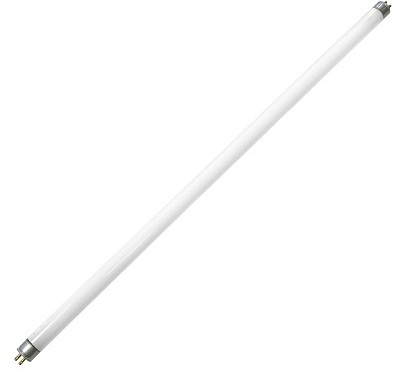
A typical "tube" fluorescent lamp with a double cover includes a bulb in the form of a glass tube, at the ends of which are soldered filament heating electrodes, the ends of which are brought out in the form of contact pins for connecting the lamp to the circuit. The inner surface of the tube is covered with a thin layer of crystalline phosphorus powder. Phosphors are substances capable of glowing under the influence of various types of excitation.
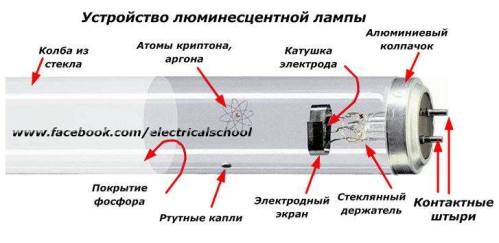
The inner space of the tube is filled with an inert gas or their mixture (neon, argon, krypton), and the tube itself is tightly sealed. A certain amount of mercury, strictly dosed, is also introduced into the flask at the lamp manufacturing stage. During the operation of the lamp, mercury becomes vapor. The vaporized mercury gives off the ultraviolet spectrum that makes the phosphor glow.
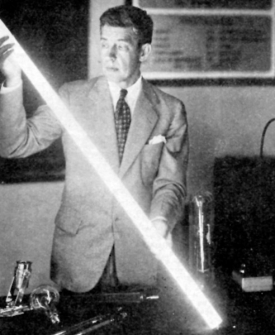
The first fluorescent lamp is believed to have been invented by Edmund Germer when, working with his team, he obtained white light from a discharge lamp in 1926. The inside of the bulb was coated with a thin layer of fluorescent powder. A little later, in 1938, when General Electric already bought Germer's patent, fluorescent lamps were introduced to the general consumer.
The first fluorescent lamps already had a light reminiscent of ordinary daylight street light on a cloudy day, whose color temperature is about 6400K. At that time, they began to call these lamps "fluorescent lamps".
On the territory of the USSR, the mass production of fluorescent lamps began in 1948, GOST 6825-64 was prepared, defining three standard sizes of linear fluorescent lamps with a power of 20, 40 and 80 watts, which have a length of 600, 1200 and 1500 mm, respectively. The diameter of the flask is 38 mm, which ensures easy ignition even at low temperatures.
There are many standard sizes of fluorescent lamps on the market today, including lamps of different wattages, with different bulb diameters, with different lengths, with different caps, and with different emitted light (according to color temperature).
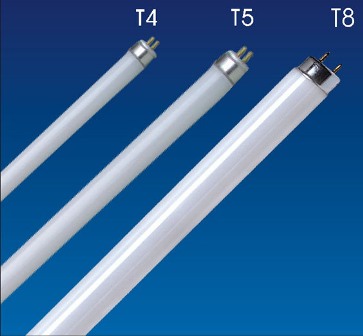
The most popular tubes are T4 (12.5 mm), T5 (16 mm) and T8 (26 mm).The first two have a G5 base, with 5mm pin spacing, and the T8 has a G13 base, with 13mm pin spacing. T8 lamps are available from 10 to 70 watts, T5 from 6 to 28 watts, and T4 from 6 to 24 watts.
Wattage is directly related to the length of the bulb. Thus, no matter what manufacturer the 18-watt lamp is, if the tube has a diameter of T8 (26 mm), then its length will be 590 mm.
Linear fluorescent lamps with different color temperatures for use in a wide variety of conditions can be found on the market today. The most popular are 6500K and 4000K. In terms of color rendering, fluorescent lamps with Ra 70-89% are the most common.
Next, we will consider the approximate technical characteristics of the most common and most commonly used linear fluorescent lamps, which can be found both in everyday life and in municipal institutions and industrial enterprises.
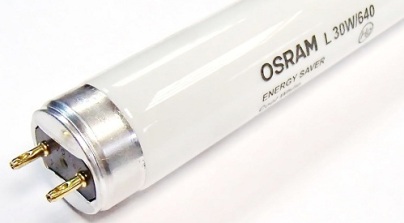
T8 Linear Fluorescent Lamp (26mm)
This is probably the most popular of this type of lamps. Lamps with a capacity of 36 watts and 18 watts, long and short, one can easily imagine when hearing the phrase "fluorescent lamp".
In general, the power range is quite wide — from 10 to 70 watts, however, 18 and 36 watts are the most common, they replaced Soviet LB / LD-20 and LB / LD-40.
Workshops, warehouses, schools, various administrative institutions, offices — everywhere T8 lamps with a G13 base. Such a lamp can last an average of 10,000 hours. To start it, a special ballast circuit based on an electromagnetic choke or electronic (electronic ballast or electronic ballast) is used. Osram and Philips have a full range of lamps in these sizes.
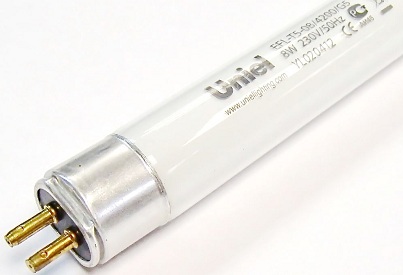
Linear fluorescent lamp T5 (16 mm)
This range of lamps is the most popular in modern living spaces. The lamps are narrow, not thick, they are easily placed in pendants, they fit well into the interior of kitchens, bedrooms, where they are installed in lamps.
The power range is from 6 to 28 watts, and in terms of luminous flux it is a complete replacement for incandescent lamps from 30 to 140 watts. Color temperatures of 6400K and 4200K are most typical for fluorescent lamps of this standard size.
The G5 base has only 5mm pin spacing. Such a lamp lasts an average of 6,000 to 10,000 hours. An electronic ballast circuit (electronic ballast) is used for starting. Uniel manufactures a full range of lamps in these sizes.
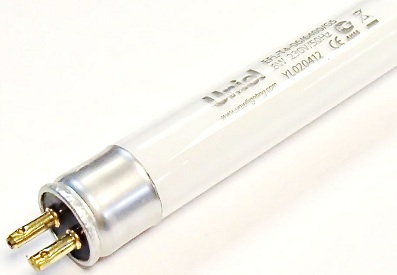
T4 Linear Fluorescent Lamp (12.5mm)
These lamps are ideal for mobile lighting. In addition, there are table lamps, where exactly T4 lamps with a G5 base fit very well. The diameter of the tube is only 12.5 mm.
The power range is from 6 to 24 watts, while a full-fledged replacement of the light flux of incandescent lamps from 30 to 120 watts is obtained. Color temperatures of 6400K and 4200K are the most typical for this type of lamp.
The service life is on average between 6000 and 8000 hours. The operation requires an electronic ballast (ECG). Uniel manufactures a full range of lamps in these sizes.
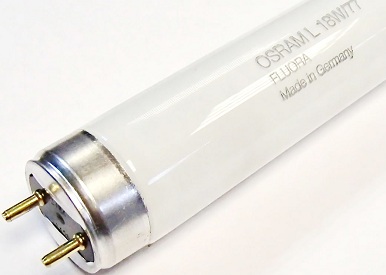
Special lamps for aquariums and plants Osram Fluora T8 type (26 mm)
These are specialized light sources with an emphasis on the blue and red regions of the spectrum. These areas of the spectrum are particularly favorable for the life processes of plants in the absence of natural sunlight and daylight, or in conditions of its deficiency. The power range is from 15 to 58 watts.
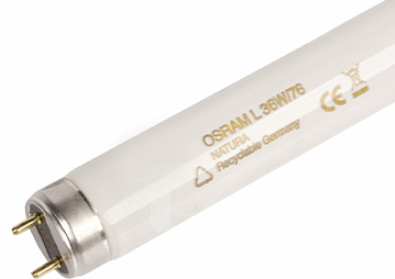
Osram Natura special lamps for food lighting type T8
The special phosphor of these lamps favorably emphasizes the natural appearance of various food products. They are installed in supermarkets, meat departments and bakeries, where it is especially important to show the freshness of the product. 76% color rendering is ideal for this purpose. The service life of special lamps is 10,000 hours, after which it is better to replace them with new ones. The power range is from 15 to 58 watts.
